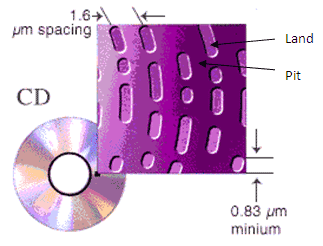CD, Compact Disc, is a quite popular storage media. It is basically an optical disc generally having a capacity of data storage equivalent to 700mb. While CDs are played they rotate around and a laser beam is used to read the data. To store data on a CD, they need to be burned. Through this short article we will discuss what this burning means and how actually data is written on the CD.
The surface of a CD is made of a polycarbonate layer with molded spiral tracks on the top. The data are stored on the CD as a series of minute grooves which are known as ‘pits’ encoded on these spiral tracks. The areas between the ‘pits’ are known as ‘lands’. These pits and lands do not represent the 1s and 0s, rather each change from pit to land or land to pit is interpreted as 0 while no change is read as 1. 

The burning process of a CD is nothing but creating a pattern of pits and lands over the polycarbonate layer. But since the data must be accurately encoded on such a small scale, the burning process must be extremely précised. A CD burner is used to write (burn) the data on a CD. It incorporates a moving laser quite similar to a CD player which is known as ‘Write Laser’. The Write Laser which is more powerful than the ‘Read Laser’, has the capability to alter the surface of CD instead of just bouncing the laser light off. During burning process, as per the data (binary values) the Write Laser bounces the light beam over the CD surface and creates a series of pits on it.
When you play the CD, the Read Laser bounces the light beams (not capable to modify the surface of CD) on the surface and detects the pits and lands. Each change between pit to land or vice versa is translated as zero and no change (pit to pit or land to land) is translated as one. These binary values form the actual data.
Filed Under: How to


Questions related to this article?
👉Ask and discuss on EDAboard.com and Electro-Tech-Online.com forums.
Tell Us What You Think!!
You must be logged in to post a comment.